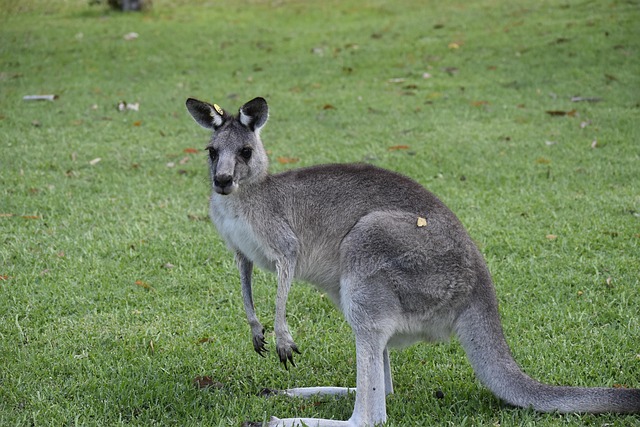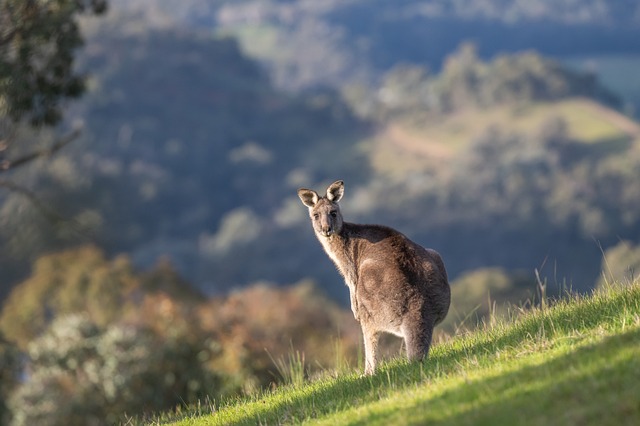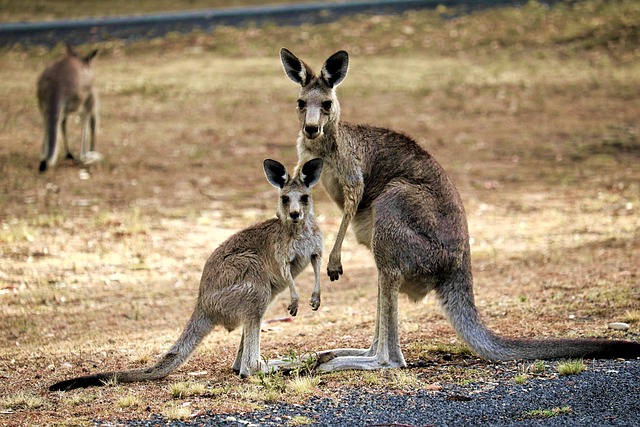Kangaroos are iconic marsupials native to Australia and are among the most recognizable animals in the world. Known for their powerful hind legs, large feet, and distinctive hopping movement, kangaroos belong to the family Macropodidae, which means “big foot.” They are a symbol of Australia’s unique wildlife and play a significant role in the country’s ecosystems.

Physical Characteristics:
Kangaroos are well-adapted to their environment. They have strong, muscular hind legs designed for hopping, which is their primary mode of locomotion. Their long, thick tails provide balance and support while hopping and can also act as a fifth limb when moving slowly. Kangaroos have large feet with sharp claws, which they use for defense and digging. Their front limbs are shorter and have five digits, which are used for grasping food and grooming.
Adult kangaroos vary in size depending on the species. The red kangaroo (Macropus rufus) is the largest, with males standing up to 6 feet tall and weighing up to 200 pounds. Females are generally smaller. Other species, such as the eastern grey kangaroo (Macropus giganteus) and the western grey kangaroo (Macropus fuliginosus), are slightly smaller but still impressive in size.
Habitat and Distribution:
Kangaroos are found throughout Australia, inhabiting a wide range of environments, including forests, grasslands, savannas, and deserts. They are highly adaptable and can survive in both arid and temperate regions. Kangaroos are social animals and often live in groups called mobs, which can range from a few individuals to over 100, depending on the availability of food and water.
Diet and Feeding Habits:
Kangaroos are herbivores, primarily feeding on grasses, leaves, shrubs, and other vegetation. They have specialized teeth for grinding tough plant material. Their digestive system is adapted to extract maximum nutrients from their food, which is essential for survival in Australia’s often harsh and nutrient-poor environments. Kangaroos are also known to regurgitate and re-chew their food, a process called “chewing the cud,” to aid in digestion.
Reproduction and Life Cycle:
Kangaroos have a unique reproductive system. Females have a pouch called a marsupium, where they carry and nurse their young, known as joeys. After a short gestation period of about 30-40 days, the tiny, underdeveloped joey is born and crawls into the mother’s pouch. Inside the pouch, the joey attaches to a teat and continues to develop for several months.
Kangaroos exhibit a phenomenon called embryonic diapause, where the development of a fertilized egg is paused until the previous joey leaves the pouch. This allows the mother to have a continuous reproductive cycle, ensuring the survival of the species in unpredictable environments.
Behavior and Social Structure:
Kangaroos are generally peaceful animals but can become aggressive when threatened. Males, known as boomers, often engage in boxing matches to establish dominance and gain access to females. These fights involve balancing on their tails and using their powerful hind legs to kick opponents.
Kangaroos are most active during the cooler parts of the day, such as early morning and late afternoon, to avoid the heat. They are also excellent swimmers and can use their strong legs to propel themselves through water when necessary.
Ecological Role:
Kangaroos play a vital role in their ecosystems. As herbivores, they help control vegetation growth, which can prevent overgrazing and promote biodiversity. They are also a food source for predators such as dingoes and eagles. Additionally, kangaroos contribute to soil health through their grazing and digging activities.
Conservation Status:
Most kangaroo species are not currently considered endangered. However, they face threats from habitat loss, climate change, and human activities such as hunting and vehicle collisions. In some regions, kangaroos are culled to manage their populations and prevent overgrazing, which can lead to conflicts between conservationists and farmers.
Cultural Significance:
Kangaroos hold a special place in Australian culture and are featured on the country’s coat of arms, currency, and various logos. They are also popular in global media, often representing Australia’s unique wildlife. Kangaroos are a source of national pride and are celebrated in art, literature, and folklore.

Conclusion:
Kangaroos are fascinating creatures that embody the spirit of Australia’s diverse and resilient wildlife. Their unique adaptations, social behaviors, and ecological importance make them a subject of interest for scientists and nature enthusiasts alike. As symbols of Australia, kangaroos remind us of the importance of preserving the natural world and its incredible biodiversity.

